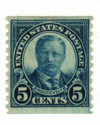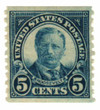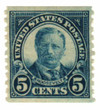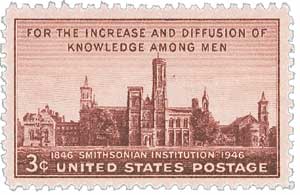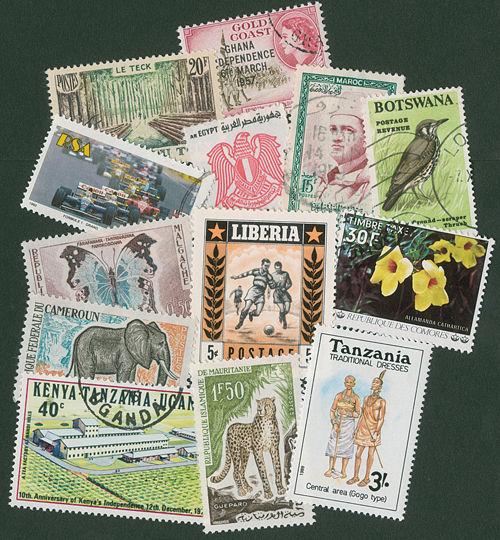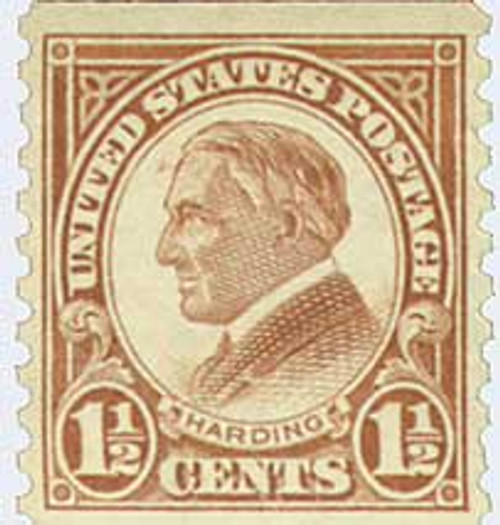
# 602 - 1924 5c Theodore Roosevelt, dark blue
Series of 1923-26 5¢ Theodore Roosevelt
First City: Washington, D.C.
Quantity Issued: Unknown
Printed by: Bureau of Engraving and Printing
Printing Method: Rotary Press
Perforation: 10 Vertically
Color: Dark Blue
Teddy Roosevelt Departs For African Safari
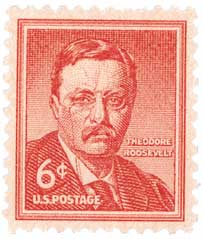
Roosevelt’s term as president ended on March 4, 1909. At 50 years old, he was America’s youngest former president. Roosevelt was anxious to take a break from politics and get out of Washington, DC. At the time, the Smithsonian was building what would become the Museum of Natural History and would need exhibits. Roosevelt, ever a fan of natural history, decided to go on an African safari sponsored by the museum to collect specimens.
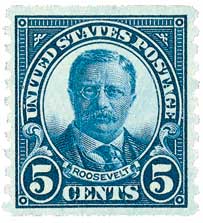 Roosevelt began his journey on March 23, 1909, accompanied by his son Kermit and three representatives from the Smithsonian. They steamed from New York to Italy, arriving in Mombasa on April 21. The expedition then boarded a train for a 581-mile train ride to Port Florence. Roosevelt described it as “the most interesting railway journey in the world.” Roosevelt then met up with the rest of his party. It would include about 250 local guides by the time it was finished.
Roosevelt began his journey on March 23, 1909, accompanied by his son Kermit and three representatives from the Smithsonian. They steamed from New York to Italy, arriving in Mombasa on April 21. The expedition then boarded a train for a 581-mile train ride to Port Florence. Roosevelt described it as “the most interesting railway journey in the world.” Roosevelt then met up with the rest of his party. It would include about 250 local guides by the time it was finished.Over the next ten months, Roosevelt’s expedition visited Kenya, the Congo, Uganda, and southern Sudan, traveling by train, horse, camel, and steamboat. During this time, they collected 23,151 natural history specimens, including about 11,397 animals. Several animals were brought back alive for the National Zoo, including a leopard, lions, cheetahs, gazelles, an eagle, a vulture, and a buteo (a broad-winged bird of prey).
In response to critics over the large number of animals captured, Roosevelt argued, “I can be condemned only if the existence of the National Museum, the American Museum of Natural History, and all similar zoological institutions are to be condemned.” Roosevelt saw the trip as a scientific endeavor, as opposed to the mass killing by other hunters there to clear land for plantations.
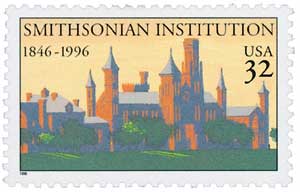
Because of the sheer number of specimens collected, it took the museum eight years to catalog them all. Several of the animals were also given to other museums. Those collected during this trip remained on display for decades, until the early 2000s. Today, only one specimen from Roosevelt’s expedition remains on display at the Smithsonian, the square-lipped rhinoceros.
Click here to read Roosevelt’s articles and here for video from the trip.
Series of 1923-26 5¢ Theodore Roosevelt
First City: Washington, D.C.
Quantity Issued: Unknown
Printed by: Bureau of Engraving and Printing
Printing Method: Rotary Press
Perforation: 10 Vertically
Color: Dark Blue
Teddy Roosevelt Departs For African Safari

Roosevelt’s term as president ended on March 4, 1909. At 50 years old, he was America’s youngest former president. Roosevelt was anxious to take a break from politics and get out of Washington, DC. At the time, the Smithsonian was building what would become the Museum of Natural History and would need exhibits. Roosevelt, ever a fan of natural history, decided to go on an African safari sponsored by the museum to collect specimens.
 Roosevelt began his journey on March 23, 1909, accompanied by his son Kermit and three representatives from the Smithsonian. They steamed from New York to Italy, arriving in Mombasa on April 21. The expedition then boarded a train for a 581-mile train ride to Port Florence. Roosevelt described it as “the most interesting railway journey in the world.” Roosevelt then met up with the rest of his party. It would include about 250 local guides by the time it was finished.
Roosevelt began his journey on March 23, 1909, accompanied by his son Kermit and three representatives from the Smithsonian. They steamed from New York to Italy, arriving in Mombasa on April 21. The expedition then boarded a train for a 581-mile train ride to Port Florence. Roosevelt described it as “the most interesting railway journey in the world.” Roosevelt then met up with the rest of his party. It would include about 250 local guides by the time it was finished.Over the next ten months, Roosevelt’s expedition visited Kenya, the Congo, Uganda, and southern Sudan, traveling by train, horse, camel, and steamboat. During this time, they collected 23,151 natural history specimens, including about 11,397 animals. Several animals were brought back alive for the National Zoo, including a leopard, lions, cheetahs, gazelles, an eagle, a vulture, and a buteo (a broad-winged bird of prey).
In response to critics over the large number of animals captured, Roosevelt argued, “I can be condemned only if the existence of the National Museum, the American Museum of Natural History, and all similar zoological institutions are to be condemned.” Roosevelt saw the trip as a scientific endeavor, as opposed to the mass killing by other hunters there to clear land for plantations.

Because of the sheer number of specimens collected, it took the museum eight years to catalog them all. Several of the animals were also given to other museums. Those collected during this trip remained on display for decades, until the early 2000s. Today, only one specimen from Roosevelt’s expedition remains on display at the Smithsonian, the square-lipped rhinoceros.
Click here to read Roosevelt’s articles and here for video from the trip.





